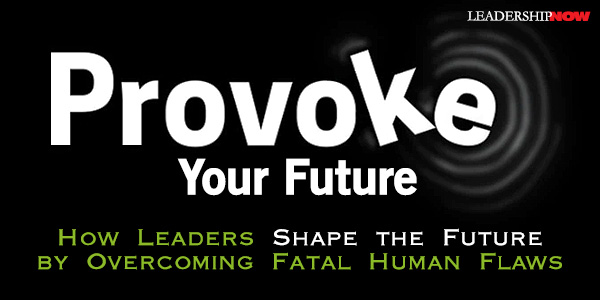 |
 |
01.28.22

Provoke Your Future
WHEN faced with uncertainty, the intuitive response is to “wait-and-see.” We get stuck in the momentum of the past and the need for solid ground, making it harder for us to capitalize on emerging trends and changes. More often, we miss them entirely and scramble to respond if we can. In Provoke, authors Steven Goldbach and Geoff Tuff explain that there are two phases to any trend: If and When. And between the two is a transition they call the Phase Change. In the initial “if” stage, it’s still uncertain if the trend will come to fruition; in the “when” stage, the trend has progressed, gathered momentum, and crossed an important inflection point where it’s no longer uncertain whether it will come to fruition. It’s only a question of when and, sometimes, to what extent.
The challenge is to get ahead of the Phase Change so that you can make the most of the emerging opportunity. The wait-and-see approach doesn’t work. You must act and provoke a better future. These days, the conviction to act—especially in the absence of perfect data—is the only way to provoke the future you desire. Action creates energy. Action allows you to position yourself to see the peak sooner and more clearly than others. Action gives you the power to move through the phase change of “if” to “when” so that you can make the most use of the kinetic energy when it is released. But how do you spot trends? And what trends? In the beginning, the signals are weak and hard to see. We easily miss them. “The best provocateurs pay attention to all weak signals, at least to begin with. As a general rule of thumb, anything that has the possibility of impacting your foundational business model—or mission—should be paid particular attention to.” To do this well, you need a model of provocation to access early and weak signals as they appear on your radar. The authors present five principles of provocation: 1. Envision the Future This is an ongoing provocation. “The most powerful envision moves involve the development of multiple scenarios or stories of how the future could unfold, along with leading indicators that help give notice when the relative likelihood of any given scenario goes up or down.”2. Position Yourself for Success While a trend is still in the “if” phase, you want to position yourself to better understand and explore the trend as it starts to reveal itself. A tend moves into the “when” phase primarily in one of two ways: naturally (no primary cause) and synthetically (happens because of action you, and usually, others take). 3. Drive Change The Drive provocation is used when the future can be driven by the organization’s own actions. “These are the provocations that allow you to act in a way that creates advantage in a world that you know is going to come true ... even if you don’t know exactly when.” 4. Adapt “In adapt, while you are still able to shape your own destiny, you believe you can’t have influence on the trend itself in a way that is perfectly consistent with your existing business model; you just need to reshape your organization to take advantage of the trend.” 5. Activate Your Ecosystem It is rare that your organization has the skills and resources required to shape the future alone. We have to look beyond our organization. “The trick for executives these days is to consider the ecosystem options in front of them in a way that allows them to make a choice that leads to advantage from participation in the direction that they have decided to provoke.” The purpose of a provoke mindset is to enable a series of minimally viable moves that continuously shape the trend as it unfolds. It’s likely that the path to provoking a better future is a smooth arc. Rather, it’s likely to require multiple small recalibrations along the way. The best strategy is a continuous learning process of aiming-acting-learning against the trend, understanding the nature of the impact you are able to have on a given trend, and leveraging minimally viable moves to make forward progress. In times like these, action beats wait-and-see. The ability to act, adapt, and act again provides an advantage in times of great change. Provoke the future. 
Posted by Michael McKinney at 02:37 PM
|
BUILD YOUR KNOWLEDGE
 

How to Do Your Start-Up Right STRAIGHT TALK FOR START-UPS 
Grow Your Leadership Skills NEW AND UPCOMING LEADERSHIP BOOKS 
Leadership Minute BITE-SIZE CONCEPTS YOU CAN CHEW ON 
Classic Leadership Books BOOKS TO READ BEFORE YOU LEAD |